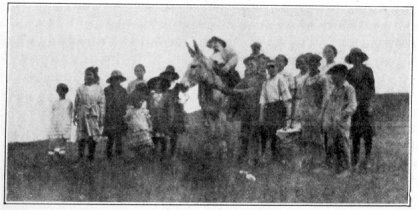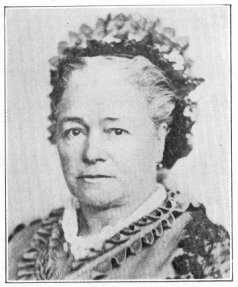
[click to enlarge]
“Judas” on the donkey, just before being led through the streets
of Hornitos and burned in the Plaza.
| Online Library: | Title | Author | California | Geology | History | Indians | Muir | Mountaineering | Nature | Management |
Yosemite > Library > Call of Gold > 33. Hi-Lights around Coulterville >
Next: 34. Hornitos • Contents • Previous: 32. Angevine Reynolds
Just after George Coulter erected his tent store on Maxwell’s Creek, which was the start of the town of Coulterville in 1850, a young man and his wife walked into the store. His name was Francisco Bruschi. They had married five months previously in Connecticut, and then started for California, via the overland route. Arriving on the stage at Bear Valley, they had walked to Maxwell’s Creek, over a rough trail, which has since become the Mother Lode Highway. He carried a compressed-air rifle, manufactured in 1838, which shot a forty-four caliber bullet and penetrated a one-inch board at a distance of seventy-five feet. This rifle has since been donated to the Yosemite Park Museum.
Francisco first started a shoe-making shop and, in the following year, a general merchandise store, which is still being operated by his two bachelor sons. Their card says, “We speak six languages, English, French, Spanish, Italian, Portuguese and Chinese.” The son, Demetrio, always known as Demet, was born in 1859 and, when quite young, attended a Chinese school in Coulterville for two years.
Demet tells some good stories about his father. Once, a big negro by the name of George Washington, ordered a pair of very large-sized boots, about number fourteen. When the boots were delivered, the negro said, “How much will you charge for enough whiskey to fill the boots to the top?” Francisco named a price and the boots were taken into the cellar to be filled. As the operation of filling was being completed, Francisco pulled at his hair and said, “I’m a goner. I’ve lost $6.50 on the deal”. The negro and his friends spent the next few days in singing and dancing on the old man’s loss.
Francisco Bruschi did considerable business with the Chinese

[click to enlarge] “Judas” on the donkey, just before being led through the streets of Hornitos and burned in the Plaza. |

[click to enlarge] Mrs. Merck, who with her husband, ran the pioneer saloon, at corner of Plaza. |
Horse racing was a quite popular early-day sport. Young Demet owned a very speedy animal by the name of Topsy. A big event was to take place at Garrotte, now called Groveland. One of his brothers wrote him, informing him of the race and asking that he not enter Topsy; that he had the race all fixed and stood to make a pile of money. Demet, disregarding his brother’s plea, had a friend trim Topsy up in a rather ragged manner, so that she was not recognizable, and enter her in the race under a different name. Even the brother failed to recognize the horse and Topsy came out winner. Demet and his friend won close to a thousand dollars, while the brother lost several hundred. He wanted to be reimbursed for the loss but was refused. The father said, “Son, don’t give your brother back his money. Gambling is a tricky game, and if one is out-tricked, he should pay the penalty. That’s the only way to gamble, that’s in the trick.”
One of the first excitements, after the town was started, was the war on the Mexicans. A white boy became acquainted, at a dance-hall, with an attractive and fascinating senorita, and ran off with her. The husband and a number of his friends pursued and in their endeavor to capture the girl, the white boy was killed. A committee of whites was organized and all the Mexicans were driven from the settlement, excepting fourteen or fifteen that were killed.
The first Justice of Peace was Captain Decatur Powell, who was killed in a drunken fight, in October, 1855. In his days of sobriety, he was an able and influential gentleman and commanded respect like most Justices of Peace did in those early days.
The young sons of the Coulterville pioneers, it has been said, went to school for the principal purpose of learning to shoot. This was a natural and almost inherited tendency, for in the early days, around them, there were a number of quite famous shots. Don Carlo, a Chilean from Jackass Creek, would let anyone throw six ten-cent pieces into the air and pay two dollars for those he did not hit with a bullet, providing he was paid ten cents for those that he hit. Then there was Jim Halstead, with his ivory-handled six-shooter, who would fire six shots at a target fifty feet distant, and every shot went into the same hole.
Martin Flannigan was a pioneer that was never forgotten by the children. He had an extremely large mouth and all he had to do was to open it, when the children would immediately scamper. He loved to play poker but was never known to come out winner. Whenever he held a good hand, his loose chin would move up and down, giving an unfailing sign to his opponents. Then there was “Manzanita Bill” Livingston, whom the children loved to gather around, while he whittled out canes and told stories. There were a number of other clever whittlers in those days when timber was plentiful; in fact, it was quite a common practice.
The old Jeffrey Hotel was built in 1853; a two-story structure of adobe brick. The town has had three disastrous fires, in the years 1859, 1879 and 1899, and in each case, in the rebuilding, some of the original buildings were slightly modernized. Just across the street from the hotel is the “Hangman’s Tree”, a large, wide-spreading oak, conveniently located and a very necessary warning in the early days.
John Thompson, present proprietor of the old hotel, is a hometown boy. He remembers the early-day elections, when the ballots were kept on a table outside a saloon and marked before being taken in to the polling place. The price paid for each vote was a few drinks and up, but the vote was a sure one. Elections were many times won by such methods. Another aid to politicians was to have a pal who could speak several languages, such as Demet.
John recalls, also, with pleasure, the times when he and other children were each paid ten cents to attend a Chinese funeral. The corpse was placed on a board and carried by four Chinese. Small bits of paper, with holes in them, were continually dropped, as the procession made its way to the burial ground. The Chinese thought that the Devil would jump into each hole, get tangled up, and finally lose his way. A nice, brown, roasted pig and some cooked rice were placed on the grave to feed the deceased on his journey to Heaven. Generally, the Indians stole the pig and rice. After a certain number of years, the bones of the Chinese men were dug up and shipped back to China. This was in accordance with a contract each of them had with the “Chinese Six Companies”, who had brought them here and agreed to return them. The bones of the women were not sent back as they came here of their own accord.
At the southern end of town, where the Mother Lode Highway crosses Maxwell’s Creek, may be seen the old concrete piers that supported a wooden trestle, fifty-three feet high, over which was operated the first steam railroad in the County. It was four miles in length and built near the turn of the nineteenth century, by the Merced Gold Mining Company, under the direction of Dan G. Kidder, prominent mining engineer. It was used to haul ore from the famous Mary Harrison mine to a forty-stamp mill on Black Creek. The engine weighed eight tons, burned wood for fuel and hauled a train of fifteen ore cars, each of which held five tons of rock. The Santa Fe R. R. Co. advertised it as “the crookedest railroad in the world”, as it followed the contours of the hills. Many of the citizens had never previously seen a railroad so the first few days, after completion, were devoted to hauling the citizens, seated on boards placed across the tops of the ore cars, up and down the length of the railroad. It was a thrill that remained a topic of conversation for many years.
Dan G. Kidder is speaking:
“Entertainment and amusement in the early history of the mining centers of Mariposa County were furnished almost exclusively by local talent and they included literary societies, spelling matches, various forms of racing and athletic sports. It seems certain from the records of accomplishments of a few of these old time athletes that if they had been provided with the intensive training given present day athletes they would have made world records.
“During the time of the mining boom in Coulterville many Cornish miners were employed who were highly skilled in the use of hammer and drill. The ‘double-jack’ hammer weighed 7 1/2 or 8 pounds exclusive of handle and it was used for drilling when two men worked together, one turning the drill steel while the other drove it into the rock with the double-jack. Especially skilled were Joseph Broan and Edward Pope. These Cornishmen were exemplary citizens and powerful men. One of the events at a fourth of July celebration was a drilling contest in which these two men won the purse by drilling a ‘down’ hole in hard blue granite a distance of 49 3/4 inches in fifteen minutes, using 7/8 inch steel and a 7 1/2 pound double-jack. To provide water for drilling, a 5-gallon oil can filled with water, to which was attached a small hose leading to the drill hole, was placed on a stand so there would be a constant supply of water. Alongside the granite block there were fifteen sharp drills ranging in length from 14 inches to 5 feet. At the word ‘Go’, one of the men held the shortest drill while the other struck it with the double-jack. The men alternated striking and changing to the next longest drill every minute, and so thoroughly skilled were Broan and Pope that no appreciable interval of time elapsed between the steady heavy blows while they changed steel and strikers. During the fifteen minutes, which was the time allowed for drilling, an average of 105 blows a minute were struck and the hole measured 49 3/4 inches.”
Tale after tale can be told about this interesting place, which still retains most of its original charm. Coulterville still lives in the center of a beautiful valley and surrounded by mines that were famous producers in early days and are destined to repeat the story.
Next: 34. Hornitos • Contents • Previous: 32. Angevine Reynolds
| Online Library: | Title | Author | California | Geology | History | Indians | Muir | Mountaineering | Nature | Management |
http://www.yosemite.ca.us/library/call_of_gold/coulterville.html